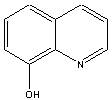
NTP Study Reports

NTP Study Reports
Home » Study Results & Research Projects » NTP Study Reports » All Long-Term Reports » Abstract for TR-276 - 8-Hydroxyquinoline

| Chemical Formula: C9H7NO | - | 3D Structure* |
|---|---|---|
| *To view structure, download free Chemscape Chime Plug-in | ||
Carcinogenesis studies of 8-hydroxyquinoline (99% pure), a metal chelator and antimicrobial agent, were conducted by administering the test chemical in feed to groups of 50 male and 50 female F344/N rats and B6C3F1 mice at concentrations of 0, 1,500, or 3,000 ppm for 103 weeks. These concentrations were selected because the chemical at higher concentrations resulted in reduced feed consumption, decreases in mean body weights, and deaths in the 15-day and 13-week studies. The average daily doses were estimated to be 73 and 143 mg/kg for male rats, 89 and 166 mg/kg for female rats, 217 and 396 mg/kg for male mice, and 349 and 619 mg/kg for female mice.
Survival of dosed male and female rats and mice in the 2-year studies was comparable to that of the corresponding controls. The high dose rats and mice of each sex exhibited slight decreases in mean body weights and decreased feed consumption.
Compound-related gross or microscopic pathologic effects were not observed in either species in the 15-day or 13-week studies. In the 2-year studies, C-cell adenomas/carcinomas of the thyroid gland showed a positive trend (P=0.03) for male rats (control, 1/50; low dose, 1/49; high dose, 6/47). The incidence of C-cell neoplasms in the high dose was not significantly increased compared with the controls, and the occurrence of C-cell hyperplasia was not elevated (4/50; 3/49; 1/47). The incidence of alveolar/bronchiolar adenomas or carcinomas (combined) in male rats with a positive trend, and the incidence in the high dose group was greater than that in the controls (0/50; 3/50; 4/50). This marginal effect was not supported by an increase in epithelial hyperplasia (5/50; 5/50; 3/50). These marginal increases in male rats were not regarded as being related to the administration of 8-hydroxyquinoline.
In in vitro tests, 8-hydroxyquinoline did not induce either unscheduled DNA synthesis in rat hepatocytes or transformation of BALB/c-3T3 cells.
An audit of the experimental data for these carcinogenesis studies on 8-hydroxyquinoline was conducted. No data discrepancies were found that significantly influenced the final interpretations.
Under the conditions of these studies, there was no evidence of carcinogenicity for male and female F344/N rats or for male and female B6C3F1 mice given 8-hydroxyquinoline in feed at concentrations of 1,500 or 3,000 ppm for 103 weeks.
Synonyms: 8-quinolinol; oxine; hydroxybenzopyridine
Report Date: April 1985
Target Organs & Incidences from 2-year Studies
You may link to the full technical report in pdf format ( Note: A print ready copy of the document is presented in Portable Document Format (pdf) which requires the Acrobat Reader plug-in -- download a free copy of the reader.)
Web page last updated on October 14, 2004
The National Institute of Environmental Health Sciences is one of the National Institutes of Health within the U.S. Department of Health and Human Services. The National Toxicology Program is headquartered on the NIEHS campus in Research Triangle Park, NC.